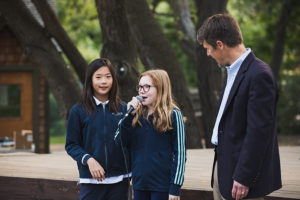 Last Wednesday at 2 PM, the skies clouded over and we had a spontaneous downpour. It was the first rain since last spring. Not a big deal, to be sure, and probably even a good thing considering how dry everything is. The problem? I was hosting an all-employee dinner at Brooke Acres that evening. Outside.
Last Wednesday at 2 PM, the skies clouded over and we had a spontaneous downpour. It was the first rain since last spring. Not a big deal, to be sure, and probably even a good thing considering how dry everything is. The problem? I was hosting an all-employee dinner at Brooke Acres that evening. Outside.
It rained for about 30 minutes, much of it torrential, and I watched from under the awning in front of the main office as the water poured down the hill past the Village of Friendly Relations. I started to wonder – what should I do? Should we cancel the dinner? Should we try to move it? And then, I took a deep breath, and did what I have found is often the best thing to do in this type of situation. Nothing.
The reality, at that point, was that if it kept raining, we were simply going to have to crowd into our living room and make the best of it. I didn’t have a good plan B. Just as importantly, it wasn’t going to help at that moment to panic and start reacting. I needed to pause and give it some time, allowing all of us to get a more realistic sense of the situation. Fortunately, it stopped raining, things dried up, and by 5:30 pm, employees were happily gathered on the Brooke Acres deck.
This moment reminded me of the story I shared at the Opening Flag of the year, Many Moons, by James Thurber. In the story, the Princess falls ill. Her father, the King, asks her what would help her get better. “The moon,” she replies. The rest of the story involves the King trying to solve what seems to him like a very complicated problem. He initially turns to a group of wise men. Getting nowhere with that group, he turns to the court jester to play him a tune to cheer him up. Before playing, the court jester asks the King a few questions and, lo and behold, they discover together that the answer to the problem can be found by talking to the Princess. Turns out, a simple golden moon pendant on a necklace makes everything better.
When I shared the story with students, I highlighted three lessons:
- When a group of wise men tell you that something is impossible – don’t believe ‘em.
- If you want to solve a problem, listen to people of all ages, including children.
- Be like the court jester – be more curious, than certain.
There was one more lesson that I didn’t share with the students, but I think is very relevant to us as adults. That lesson? When your child shares a problem with you, pause, wait, and really listen, before you try to solve it. Or, as well-known Bay Area family therapist and parent educator Sheri Glucoft-Wong encouraged all of us to do a few years ago during a presentation to our parent community, just say “oh.” That’s right, instead of offering solutions or asking a lot of questions, say, “oh” and then stop. You will often be surprised by what happens next.
For many of us, this lesson goes against our instincts. Throughout our lives, we have been recognized for being problem solvers. We have been rewarded for our ability to find creative solutions, to analyze difficult situations, and find ways to make them better.
And yet, as the King discovered, children often have the answers to their own problems. All too often, adults hear a child’s problem – “you want the moon?” – and immediately look at it through an adult lens. How many times have we seen our child near hysterics because someone was mean to them at school? As an adult, we may quickly assume that there is a significant conflict here, something that needs to be addressed. What should we do – email the teacher? Reach out to the other parent? Give our child strategies for dealing with the other child the next day?
If we stop and pause, before we act, however, we may discover that our child doesn’t want us to do anything more than just listen. They are often looking for us to be a calm, steady presence, the person they can fall apart with after a long hard day. Indeed, in many cases, children will pull themselves back together and put this behind them in a matter of minutes. “Everything ok?” you might ask in twenty minutes. “Huh?” they might look at you, as they run off to play with the dog. “Was something wrong?”
If, on the other hand, we jump in and attempt to solve the problem, we may find ourselves escalating the situation. If we reach out to bring together a group of adults, for example, we may find ourselves using an adult lens to solve a childhood problem. Even with the best of intentions, we can create confusion and complexity, when what children need is consistency and compassion. Like the King and the wise men, we don’t understand the problem, and thus we inadvertently make it worse. Instead of listening and seeking understanding, we act, and in the process we create solutions that don’t work for anyone.
The other downside to solving children’s problems for them is that it inadvertently suggests to them they are not resilient enough to handle their own challenges. In the second half of Many Moons, the King is fearful of what will happen when the Princess discovers that the golden moon on the chain around her neck is not the “real moon.” The wise men suggest a series of solutions that involve hiding the truth from the Princess.
In her classic book from the 1990s, “Blessings of a Skinned Knee,” Wendy Mogel pointed out to parents that difficult situations are often our children’s most important teachers. She mentions the value of classrooms with conflicts, the learning that happens when a child is disappointed and frustrated, the lessons that come from falling down and skinning a knee.
I played a lot of sports as a child, and was on a wide variety of high school and competitive teams. Only one person from my childhood made it to the elite levels of his sport, competing in the 2000 Olympics in Sydney, Australia. At the beginning of our sophomore year of high school, he was cut from the soccer team. He was devastated. To make it worse, he was the only one of my friends who didn’t make the team. So what did he do? He switched gears and went out for Cross Country. Three years later he was one of the top three runners on our district championship team. The next year he discovered a new and related track and field sport – race walking, and by the end of his senior year in college he was one of the top race walkers in the country. I have often thought about what a gift it was for him to have been cut from the team.
At the end of story, the King and the Court Jester approach the Princess with dread, as she is lying in bed looking at the moon through her window. “How can the moon be shining in the sky when it is hanging on a golden chain around your neck?” they ask. She replies with a laugh, pointing out that when she loses a tooth a new one grows in its place, and when the unicorn loses his horn in the forest, a new one grows in the middle of his forehead, and when the royal gardener cuts flowers in the garden, other flowers come to take their place. Thus, she declares, “It is the same way with the moon.” Indeed, she adds, “I guess it is the same way with everything.”
During the opening Flag, a 1st grader leaned over to Head of Lower School Colleen Schilly when I mentioned how a unicorn horn grows back after it is lost. “Unicorns are real?” So many possible answers. What would you have said?
